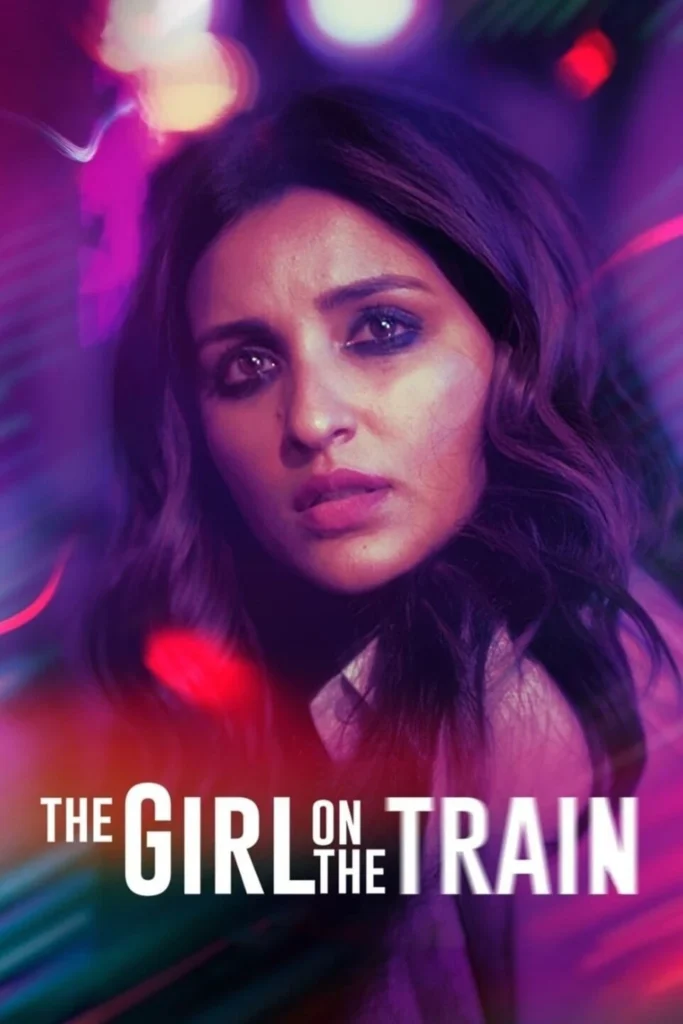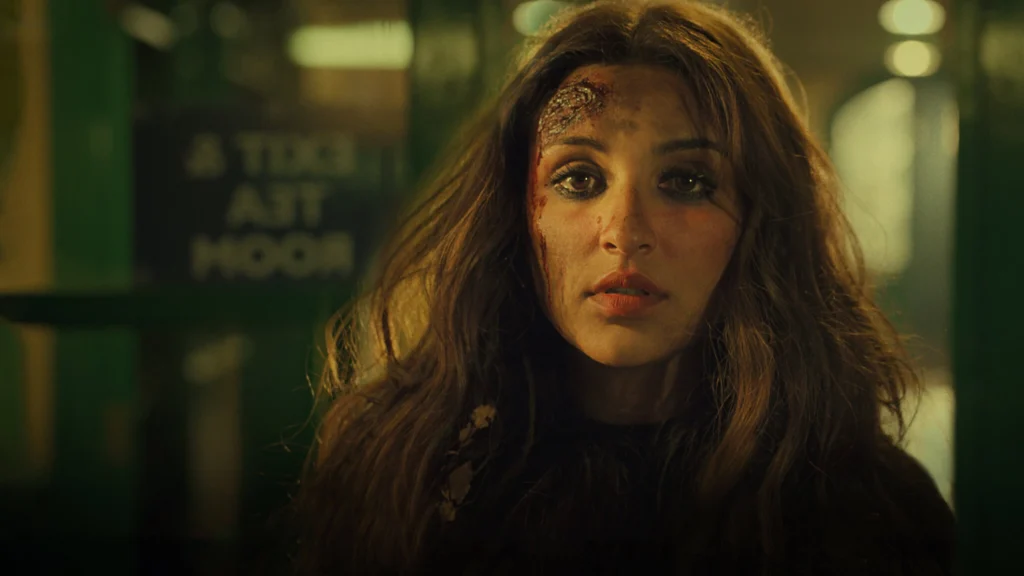“The Girl in a Train” movie is a gripping psychological thriller that blends suspense, mystery, and emotional depth. Adapted from Paula Hawkins’ bestselling novel, it takes viewers into a tense world where secrets and lies create an atmosphere of constant doubt. The story is set in a seemingly peaceful neighborhood, but beneath the surface lies a network of betrayal and hidden motives. Each frame draws the audience deeper, urging them to question what they see and hear.
More than just a mystery, the film is an exploration of human emotions and the fragility of trust. It examines how trauma and personal loss can distort reality, making the truth difficult to identify. Every scene is crafted to maintain intrigue, with the pacing ensuring that revelations arrive at just the right moment. This combination of emotional depth and thrilling suspense makes it stand out among modern cinematic adaptations.
🕵️♀️ The Plot Overview
The story follows a troubled woman whose daily train commute takes an unexpected turn into mystery. From her seat, she watches a neighborhood she passes each day and becomes fixated on a seemingly perfect couple. Her quiet observations become unsettling when she witnesses something unusual, setting off a chain of events that lead her into a dangerous investigation.
As she searches for answers, she struggles with an unreliable memory and emotional instability. The plot cleverly alternates between timelines and perspectives, revealing fragments of the truth in carefully placed pieces. Every twist intensifies the suspense, making it nearly impossible to predict the outcome. The final act delivers a conclusion that is as shocking as it is satisfying.
🎭 The Main Characters in The Girl in a Train Movie
The protagonist is portrayed as both fragile and fiercely determined, a combination that makes her journey compelling to watch. Her vulnerability adds depth to her character, making her determination to uncover the truth even more powerful. She is not a flawless hero but a deeply human figure, shaped by her struggles and mistakes.
The supporting characters are equally layered, each hiding motives that slowly come to light. From the seemingly perfect couple to the enigmatic neighbors and friends, no one is above suspicion. Their interactions are loaded with subtle cues, leaving the audience unsure of who can be trusted. This uncertainty adds richness to the mystery and keeps viewers engaged.
🎬 Direction and Cinematic Style
The film’s direction captures the claustrophobic tension of the story with skill and precision. The director uses close-up shots to pull viewers into the protagonist’s emotional state, while wide, lingering shots of the train and neighborhood build an atmosphere of unease. The muted color palette and deliberate lighting choices visually reflect the uncertainty at the heart of the film.
Symbolism plays a major role in the visual storytelling, with the constant motion of the train mirroring the protagonist’s unsettled mind. Reflections in windows and mirrors further emphasize her fractured perspective. Every visual detail, from pacing to framing, contributes to the audience’s sense of immersion and connection with the unfolding drama.
🎶 Soundtrack and Background Score in The Girl in a Train Movie
The soundtrack is carefully designed to enhance the film’s suspense and emotional depth. Haunting piano melodies and subtle string arrangements create an atmosphere that shifts between melancholy and tension. Sharp musical accents are used to heighten moments of shock, while ambient sounds like the train’s rhythmic clatter ground the story in realism.
Silence is also used to powerful effect, amplifying scenes of dread or introspection. The score reflects the protagonist’s unstable mental state, alternating between calm and chaos. This blend of sound design and music ensures that the emotional weight of each scene is fully felt, even without visual context.
🏆 Performances and Acting Highlights
The cast delivers performances that feel authentic and emotionally raw. The lead actress captures the protagonist’s fragility and resilience with remarkable precision, drawing viewers into her internal struggle. Her portrayal is layered, making her both relatable and unpredictable.
Supporting actors bring depth to the story through nuanced performances that reveal their characters’ hidden sides. Every interaction feels charged with tension, adding to the overall mystery. Together, the ensemble elevates the film beyond a standard thriller into a character-driven masterpiece.
📚 Comparison with the Novel
The movie remains faithful to the central themes of Paula Hawkins’ bestselling novel but makes certain adjustments for cinematic pacing. Key events are streamlined, and some side characters receive reduced screen time to keep the narrative focused on the main mystery. This adaptation choice ensures the suspense remains high while still honoring the spirit of the source material.
However, the shift from page to screen naturally alters how internal thoughts are presented. Where the novel relied on the protagonist’s inner monologue, the film uses visual cues, body language, and symbolic imagery to convey emotional states. This change offers a more immersive experience for viewers, though some novel purists may miss the intricate psychological detail of the book.
🌍 Setting and Location in The Girl in a Train Movie
The setting plays a crucial role in shaping the atmosphere of the story. The train becomes more than just a mode of transport—it is a moving stage from which the protagonist observes lives unfolding outside her window. Passing suburbs, quiet streets, and isolated houses form the visual backdrop for the unfolding mystery.
The choice of filming locations enhances the feeling of both intimacy and detachment. Audiences get glimpses into private lives from a distance, reflecting the theme of partial truths and limited perspectives. The muted colors and overcast skies add to the film’s somber mood, perfectly complementing the psychological tension at its core.

💡 Themes and Underlying Messages
The movie explores themes of perception, trust, and the consequences of trauma. It questions how personal experiences shape our understanding of reality and how easily the truth can be distorted. Through the protagonist’s unreliable viewpoint, the audience is invited to reflect on the fragility of memory and the dangers of making assumptions.
It also addresses deeper emotional issues such as isolation, grief, and the human need for connection. The portrayal of flawed characters who are neither fully innocent nor entirely guilty adds moral complexity to the story. By blurring the lines between right and wrong, the film leaves viewers with questions that linger long after the credits roll.
📈 Critical Reception of The Girl in a Train Movie
The film received a mix of reviews upon release, with praise directed toward the performances and atmospheric direction. Critics appreciated its faithful adaptation of the book’s core mystery and the tension it maintained throughout. The lead actress’s portrayal was singled out as a highlight, offering depth and emotional authenticity to the character.
However, some felt the pacing was uneven, particularly in the middle act where certain scenes lingered longer than necessary. Despite these critiques, the movie found its audience among fans of slow-burn thrillers. Over time, it has gained recognition as a solid adaptation that successfully translates the book’s essence to screen.
🎯 Audience Response and Popularity
Audiences responded strongly to the film’s mystery and emotional depth. Viewers who had read the novel enjoyed seeing familiar scenes brought to life, while newcomers appreciated the unpredictable twists and intense performances. The film’s layered narrative encouraged discussion and debate about the true nature of events.
Its popularity was boosted by online conversations, fan theories, and multiple re-watches that revealed subtle details missed on the first viewing. For many, the movie offered both an engaging mystery and an emotional journey, making it a favorite among psychological thriller enthusiasts.
🔮 Legacy and Influence
The girl in a train movie has contributed to the continued popularity of book-to-film thrillers. Its blend of psychological complexity and suspense has influenced later adaptations, proving that faithfulness to source material can coexist with cinematic creativity. The film has also introduced the story to audiences who may never have read the book.
In the years since its release, it remains a touchpoint in discussions about unreliable narrators in cinema. Its atmospheric style, strong performances, and focus on character psychology have helped it maintain relevance, ensuring its place in the modern thriller canon.
❓ Frequently Asked Questions about The Girl in a Train Movie
1. What is the girl in a train movie about?
The girl in a train movie follows a troubled woman whose daily train commute becomes the backdrop to a gripping mystery. She observes a couple from her train window, imagining their lives to be perfect, until she witnesses something shocking. This incident sets her on a path to uncover the truth, intertwining her own troubled past with the unfolding events.
The story blends psychological drama with mystery, offering a mix of suspenseful twists and deep emotional exploration. It challenges the viewer’s perception of truth, making it more than just a conventional thriller.
2. Is the girl in a train movie based on a book?

Yes, the movie is adapted from Paula Hawkins’ bestselling novel of the same name. The book was celebrated for its complex characters and its use of an unreliable narrator, which adds to the tension. Fans of the book will recognize many of the key plot points and character arcs in the film.
While the adaptation makes some changes for pacing and cinematic impact, it retains the core essence of the novel. The film’s visual storytelling replaces much of the book’s internal monologue, giving a new dimension to the narrative.
3. Who plays the lead role in the girl in a train movie?
The lead role is played by a talented actress who delivers a deeply nuanced performance, capturing both the fragility and determination of the protagonist. Her portrayal is widely praised for its emotional authenticity and ability to hold the audience’s attention.
This performance is one of the film’s standout elements, bringing the character’s psychological complexity to life. It anchors the story, making the viewer invested in her journey from confusion to clarity.
4. What makes the movie different from other thrillers?
The girl in a train movie stands out because of its blend of psychological depth and mystery. Rather than focusing solely on action or crime-solving, it delves into the emotional and mental state of its protagonist. The use of an unreliable narrator keeps the audience guessing about what is real and what is imagined.
Its pacing, atmospheric visuals, and strong character development give it a more intimate and layered feel than standard thrillers. These qualities make it a compelling watch for fans of complex storytelling.
5. Where was the girl in a train movie filmed?
The movie was filmed in a combination of real train routes and carefully designed sets. The suburban neighborhoods and train interiors play a vital role in creating the story’s atmosphere. The production team worked to make these settings feel authentic yet slightly unsettling.
The choice of muted colors and overcast weather conditions enhances the mood of uncertainty. Each location complements the film’s themes of isolation and fragmented perception.
6. Is the story told in a linear way?
No, the film uses a non-linear narrative, moving between different timelines and perspectives. This structure mirrors the protagonist’s confused and unreliable memory, making the viewer piece together the events alongside her. Flashbacks are carefully placed to reveal new information without breaking the tension.
This non-linear approach keeps the mystery alive, preventing the audience from predicting the resolution too soon. It also allows for deeper character development as backstories are revealed gradually.
7. How does the soundtrack impact the movie?
The soundtrack plays a significant role in building tension and guiding emotions. Haunting melodies and sharp musical cues amplify suspense, while strategic silences create unease. Ambient sounds, such as the rumble of the train, make scenes more immersive.
This blend of music and sound design enhances the psychological impact of key moments. The score mirrors the protagonist’s mental shifts, adding depth to her journey.
8. Does the movie have any major twists?
Yes, the movie features several major twists that change the audience’s understanding of events. These twists are revealed through the gradual uncovering of secrets, both from the protagonist’s past and the people she observes. They are placed strategically to keep viewers engaged until the end.
The final twist is particularly impactful, offering a resolution that is both surprising and emotionally satisfying. It ties together the film’s themes of truth, trust, and self-discovery.
9. What themes are explored in the girl in a train movie?
The film explores themes of perception, memory, trust, and the effects of trauma. It examines how personal experiences can distort reality and how assumptions can lead to dangerous misunderstandings. These themes give the story emotional weight beyond its mystery elements.
It also highlights the idea that people are rarely entirely innocent or guilty. This moral complexity adds richness to the narrative, leaving the audience with questions to ponder.
10. Who should watch the girl in a train movie?
This movie is ideal for fans of psychological thrillers, mystery dramas, and character-driven narratives. Viewers who enjoy slow-burn suspense and stories that require attention to detail will find it particularly engaging.
It’s also recommended for those who appreciate adaptations of well-written novels. The combination of strong performances, atmospheric visuals, and a gripping plot makes it worth watching at least once.
You can visit our other review ⚠️🚨⚠️ Faraaz Movie :Review A Bold Retelling of Bravery and Terror 🎬





One thought on “The Girl in a Train Movie : Story, Cast, Review, and Complete”